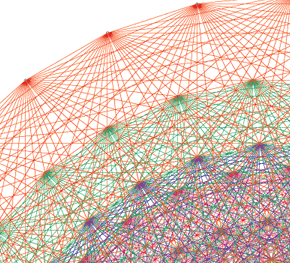
NEXT ENTRY »
Why audiophiles are dying out

That spirograph-like doodle above? It’s a small chunk of this much larger diagram — and, if you believe a radical new theory, it might finally explain the fabric of the universe.
It’s also got a lovely backstory. It begins with one Garrett Lisi, a 39-year-old physicist who is affiliated with no university. Indeed, he’s kind of broke, because he spends most of the year surfing and snowboarding. But anyway, a while ago Lisi got intrigued by the properties of E8, a complex — discovered in 1887 — that encapsulates the symmetries of a 57-dimensional object, and which itself possesses 248 dimensions. Lisi had been thinking about the failures of the “Standard Model” of physics, which has never been able to explain how gravity works. (String theory has been the only rival model that offers an explanation of gravity.) And he was thinking about the vast and baffling array of fundamental particles that make up the universe — and the many particles predicted by string theory, but not yet observed in real-world experiments
Then Lisi had a breakthrough. He realized that the shape of E8 could be used as a sort of map, to explain the particles and their relationships. As a story in the Telegraph reports:
“My brain exploded with the implications and the beauty of the thing,” he tells New Scientist. “I thought: ‘Holy crap, that’s it!’”
What Lisi had realised was that he could find a way to place the various elementary particles and forces on E8’s 248 points. What remained was 20 gaps which he filled with notional particles, for example those that some physicists predict to be associated with gravity.
Physicists have long puzzled over why elementary particles appear to belong to families, but this arises naturally from the geometry of E8, he says. So far, all the interactions predicted by the complex geometrical relationships inside E8 match with observations in the real world. “How cool is that?” he says.
Lisi wrote up his idea in a paper — “An Exceptionally Simple Theory of Everything” — that he published online last November. Interestingly, since his schema predicts the existence of particles we haven’t yet seen, it will, as he points out, “either succeed or fail spectacularly”. This is nice, since of course one of the big problems afflicting fringe, mail-order doctorate physicists who offer Unified Theories of Everything is that they rarely posit how their concepts of harmonic convergence can ever be proven or disproven. (And believe me, after years of science journalism, I know this the hard way, because I’ve been snailmailed copies of self-published theories that are riddled with simply Rosicrucian weirdness.) It’s even more impressive given that the mythopoeic dimensions of Lisi’s life — a new theory of everything! developed by a surfer! based on a design that wouldn’t be out of place on your pothead cousin’s van! — would seem to fall straight into tinfoil-hat territory.
Nonetheless, despite the promise of testability, Lisi’s ideas have provoked a minor food-fight in the lunchroom of theoretical physics. The Wikipedia page for “An Exceptionally Simple Theory of Everything” has a pretty good summary of it. It’s been called everything from “beautiful stuff” to “childish misunderstandings.” Alas, grasshopper, I lack the math fu and physics fu to even begin to figure out whether Lisi is on to anything. But now I want a poster of E8 for my wall! Dude.
(Thanks to Julian Harley for this one!)
I'm Clive Thompson, the author of Smarter Than You Think: How Technology is Changing Our Minds for the Better (Penguin Press). You can order the book now at Amazon, Barnes and Noble, Powells, Indiebound, or through your local bookstore! I'm also a contributing writer for the New York Times Magazine and a columnist for Wired magazine. Email is here or ping me via the antiquated form of AOL IM (pomeranian99).

ECHO
Erik Weissengruber
Vespaboy
Terri Senft
Tom Igoe
El Rey Del Art
Morgan Noel
Maura Johnston
Cori Eckert
Heather Gold
Andrew Hearst
Chris Allbritton
Bret Dawson
Michele Tepper
Sharyn November
Gail Jaitin
Barnaby Marshall
Frankly, I'd Rather Not
The Shifted Librarian
Ryan Bigge
Nick Denton
Howard Sherman's Nuggets
Serial Deviant
Ellen McDermott
Jeff Liu
Marc Kelsey
Chris Shieh
Iron Monkey
Diversions
Rob Toole
Donut Rock City
Ross Judson
Idle Words
J-Walk Blog
The Antic Muse
Tribblescape
Little Things
Jeff Heer
Abstract Dynamics
Snark Market
Plastic Bag
Sensory Impact
Incoming Signals
MemeFirst
MemoryCard
Majikthise
Ludonauts
Boing Boing
Slashdot
Atrios
Smart Mobs
Plastic
Ludology.org
The Feature
Gizmodo
game girl
Mindjack
Techdirt Wireless News
Corante Gaming blog
Corante Social Software blog
ECHO
SciTech Daily
Arts and Letters Daily
Textually.org
BlogPulse
Robots.net
Alan Reiter's Wireless Data Weblog
Brad DeLong
Viral Marketing Blog
Gameblogs
Slashdot Games